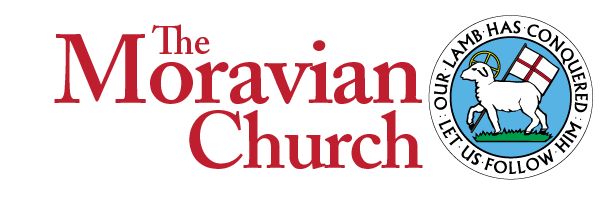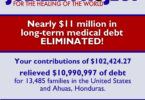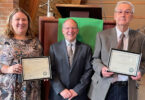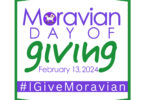Communicating in today’s faith landscape has gone so far beyond newsletters and pulpit announcements. While those methods of sharing information are still the cornerstones of many congregation’s communication activities, there’s so much more to reaching out and engaging church members and communities.
But if you have a limited budget, limited resources or limited know-how, how does a congregation take advantage of the many tools and opportunities for sharing the good news – and the Good News – with their constituents?
I could write a book on church communication – on strategy, on tactics, on implementation, on resources – but fortunately, there are a broad range of books already written on the topic that do a much better job than I ever could. I want to share three of those books with you, each of which I highly recommend to any congregation or ministry team looking to up their communication game.
First is the smallest and simplest, yet a great place to start: Dangerous, A Go-To Guide for Church Communication, edited by 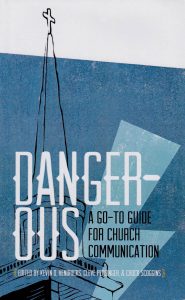 Kevin D. Hendricks, Cleve Persinger and Chuck Scoggins. This little book – it’s only 80 pages long – provides an essential jumping off point for those who want to get serious about improving their communication.
Kevin D. Hendricks, Cleve Persinger and Chuck Scoggins. This little book – it’s only 80 pages long – provides an essential jumping off point for those who want to get serious about improving their communication.
Dangerous collects short articles from church communicators across the country, with topics ranging from “5-Minute Church Communication Strategy” and “How to Do a Communications Self-Audit” to “5 Ways to do Church Communication on the Cheap,” “The Forgotten Few Minutes Before Church,” “Top 5 Elements for a Church Site” and “7 Things Every Church Facebook Expert Should Know.”
The brief, easily digestible yet highly informative articles collected in Dangerous help readers think through church communication activities and how to get involved without getting in over your head. What I found most beneficial from this book is how it provides the sense that with time and effort, anyone can get started improving church communication.
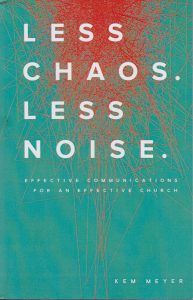 The next of my favorite church communication books is Kem Meyer’s Less Chaos. Less Noise: Effective Communications for an Effective Church. This book goes deeper than Dangerous, providing a broader range of strategies, solutions and best practices that can help you reach your audience more effectively.
The next of my favorite church communication books is Kem Meyer’s Less Chaos. Less Noise: Effective Communications for an Effective Church. This book goes deeper than Dangerous, providing a broader range of strategies, solutions and best practices that can help you reach your audience more effectively.
Meyer’s background was in corporate communications before leading communications at a large community church in Indiana. There, she applied her corporate skills to helping the congregation vastly improve their outreach and connections. In her first book from 2011, Less Clutter. Less Noise., Meyer brought a new view to communicating church; her new book builds on this work.
In Less Chaos… Meyer tackles several “myths” of communication and offers ways to overcome communication barriers that can make getting your message across a bewildering challenge. She provides useful strategic frameworks, tips on choosing the right media for your messages and ideas on small-budget methods for improving church communication.
Less Chaos is a higher-level book and may seem written for churches with their own communication staffs. One of the things I like best about Meyer’s style is that it is approachable, understandable and, most importantly in our Moravian context, applicable to churches of all sizes.
The newest book in my collection is Rethink Communication: A Playbook to Clarify and Communicate Everything in Your Church, by Phil Bowdle. Published this year, Rethink looks at some of the new realities of reaching audiences with your 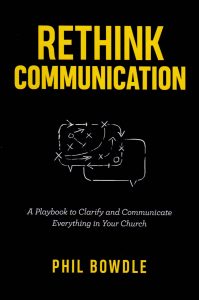 messages. “The old communication playbook no longer works,” reads the description for Rethink. “What worked before isn’t working anymore. It’s time to rethink communication and leverage the greatest opportunities we’ve ever had to communicate in the church.”
messages. “The old communication playbook no longer works,” reads the description for Rethink. “What worked before isn’t working anymore. It’s time to rethink communication and leverage the greatest opportunities we’ve ever had to communicate in the church.”
In this fun-to-read, insightful book, Bowdle lays out his views on the recent climate that affects member attention, engagement and attendance. He then guides readers through reviewing current communication efforts, clarifying messages, building a solid strategic communication plan (something I heartily recommend) and ways to implement those plans to the best affect. The final section of the book provides ways to rethink and rework how church communication happens in your setting.
These three books offer approachable guidance (and fun reading) about church communication. When I counsel congregations on communication methods, I constantly cite these works and recommend they be added to church office libraries. All three are available from Amazon; at list price, this little library will cost less than $40, yet provide a valuable start to improving communication within your church.
One more resource I recommend: The Center for Church Communication (who actually published Dangerous and Rethink Communication, among other great books). Their embarrassingly named yet fantastic website, “Church Marketing Sucks” (www.churchmarketingsucks.com) is a treasure trove of ideas, resources and activities. If you are involved with communication at your church, visit there today.
Mike Riess is executive director of the Interprovincial Board of Communication and editor of The Moravian Magazine. For additional resources and communications counsel, reach Mike at [email protected].
